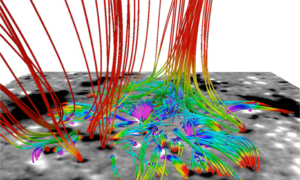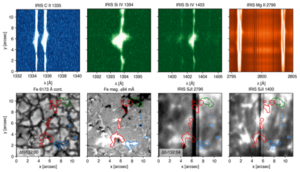Questions
How is the solar magnetic field maintained? And how does it impact the solar atmosphere? This research includes understanding how this field is generated, transported, and dissipated on the Sun.
Approach
To study the magnetic field on the Sun, I use high-resolution, ground-based, and space-borne observations, employing various state-of-the-art techniques.
Innovations & Discoveries
My collaborators and I have shown that small-scale magnetic fields in the quiet regions of the solar surface, known as internetwork fields, are the main source of magnetic flux in the quiet Sun. This renders the internetwork an essential contributor to the flux and energy budget of the solar photosphere. These small-scale fields may also locally heat the upper solar atmosphere.
Technical Description
My work is focused on the origin, properties, and spatio-temporal evolution of small-scale quiet Sun magnetic fields. These fields consist of highly dynamic, short-lived magnetic structures that populate the interior of supergranular cells and strong kilogauss fields forming the so-called network around them. Since internetwork fields are weak and produce tiny polarization signals, I use high-sensitivity, high-resolution observations to detect them. Such observations are taken in different spectral lines to sample different layers of the solar atmosphere. I employ feature-tracking algorithms, inversions of the radiative transfer equation, and magnetic field extrapolation techniques to study the solar magnetic fields.
The results derived from my work drew attention to the importance of internetwork fields. They fundamentally changed the way in which we understand how small-scale quiet Sun magnetic fields appear, evolve, and disappear from the solar surface. My collaborators and I were able, for the first time, to describe in a consistent way the processes by which magnetic fields are brought to and removed from the solar photosphere, which resulted in a complete change of a paradigm that the “quiet” Sun magnetic structures are formed by large-scale magnetic fields. Our work demonstrated that the main sources of the quiet Sun magnetic flux in the photosphere are small-scale internetwork fields that appear inside supergranular cells, most likely due to the local dynamo. These fields can eventually cause magnetic reconnection that releases energy and locally heats the solar atmosphere. Therefore, to understand solar magnetism, it is important to investigate and understand internetwork fields. Such small-scale fields set the stage for many types of solar activity and are the key to understanding how the solar atmosphere is heated. This has considerable consequences for human society, as it directly affects our environment, such as space missions, GPS, telecommunications infrastructure on the ground (and in the air and in space), electric power grids, and the Earth’s climate.
Publications
ORCiD
Trajectories of selected magnetic elements in the solar photosphere, plotted in different colors. The background image is a Hinode/Narrowband Filter Imager (NFI) magnetogram in which positive polarity magnetic elements (fields) appear in white and negative in black. The border of the supergranular cell where network elements reside is marked with red and yellow dots. The trajectories indicate that internetwork elements migrate toward the network where they deposit their flux.
Snapshot from a magnetofrictional simulation of a Hinode data set. Extrapolated magnetic field lines are plotted for selected magnetic elements over the corresponding magnetogram. The different colors indicate the cosine of the magnetic field inclination, from +1 (violet, positive polarity) to -1 (red, negative polarity). Following the magnetic field lines, we can examine the connectivity between magnetic features visible in the photospheric magnetograms.
Upper row: Enhanced emission in the IRIS far-ultraviolet (FUV) and near-ultraviolet (NUV) spectral regions above emerging internetwork fields. From left to right, the panels show IRIS measurements in the C II 1335, Si IV 1394, Si IV 1403, and Mg II 2796 spectral domains. Bottom row: Solar granulation (continuum intensity) map and a photospheric magnetogram in the Fe I 6173 Å line taken with the Swedish 1-m Solar Telescope (SST), showing newly emerging fields in the photosphere. The last two panels show IRIS slit-jaw images at 2796 Å and 1400 Å. These intensity maps reveal bright loops connecting magnetic footpoints. Together, these SST and IRIS measurements show how internetwork fields locally heat the solar atmosphere. This occurs in the upper chromosphere and the transition region through reconnection processes between preexisting ambient fields and the emerging internetwork fields.
External Links
AAS Nova TecnoXplora Projects
Interface Region Imaging Spectrograph (IRIS), PI: Prof. Bart De Pontieu, Lockheed Martin Solar and Astrophysics Laboratory (LMSAL)
IRIS is a NASA Small Explorer Mission developed and operated by LMSAL. The main goal of the IRIS mission is to understand how the solar atmosphere is energized. IRIS obtains UV spectra and images with high spatio-temporal resolutions observing the chromosphere and transition region of the Sun, an interface region between the photosphere and corona.
My role is to investigate how small-scale solar magnetic fields affect the dynamics and energetics of the solar atmosphere using IRIS observations. I also support science operations of the IRIS mission on a day-to-day basis. This includes making IRIS observing timelines, training new solar physicists to observe with IRIS, and to coordinate joint IRIS and ground-based observations.
Solar-B (Hinode) Focal Plane Package, PI: Dr. Marc DeRosa (LMSAL)
Hinode is a Japanese mission developed and launched by the Institute of Space and Astronautical Science/Japan Aerospace Exploration Agency (ISAS/JAXA), with the National Astronomical Observatory of Japan (NAOJ) as a domestic partner and NASA and the Science and Technology Facilities Council (STFC) (UK) as international partners. The scientific goals of the Hinode mission are to understand the processes of magnetic field generation and energy transport from the photosphere to the corona and to determine the mechanisms responsible for eruptive phenomena such as flares and coronal mass ejections. I use Hinode observations to study the spatio-temporal evolution of the photospheric solar magnetic fields.
Flux emergence and the structure, dynamics, and energetics of the solar atmosphere, PI: Prof. Viggo H. Hansteen (BAERI)
On this project we use state-of-the-art numerical radiative-magnetohydrodynamical simulations to study how magnetic fields are generated both in the quiet Sun and active regions, with the goal to understand the origins of the Sun’s activity. My role is to validate the simulations by comparing them with real solar observations.
From kilogauss patches to open flux: recharting the magnetic landscape of the solar polar region, PI: Dr. Xudong Sun (University of Hawaii Institute for Astronomy (UHIfA))
The goal of this project is to provide a state-of-the-art view of the polar magnetic regions and to improve estimates of the open magnetic flux. I analyze the properties and spatio-temporal evolution of polar flux patches and how they affect the large-scale open magnetic flux structures. Education
- PhD, cum laude, University of Granada, 2015. Supervisor: Dr. Luis Ramón Bellot Rubio. The solar internetwork.
- MS, University of Granada, 2012. Supervisor: Dr. Luis Ramón Bellot Rubio. Properties and evolution of magnetic elements in the solar internetwork.
- BS, Astrophysics, Belgrade University, 2009.
Get in touch: gosic (at) baeri.org
About Milan
Where are you from, and what were you doing before BAERI?
I grew up in a small village in Serbia, which is at the crossroads between central and southern Europe. I currently live in Sunnyvale, CA. Before joining BAERI in January 2016, I was a PhD student at the Instituto de Astrofísica de Andalucía. This is one of the top-tier research institutes devoted to research in the field of astrophysics and the development of instrumentation for telescopes and spacecrafts. During my PhD, I visited LMSAL in 2013 and 2015.
What’s one job-related thing that you love talking about with other people?
I enjoy talking about mechanisms that generate the magnetic field of the Sun.
How about an interest outside of work?
I love music, especially flamenco guitar. It seems that Granada has left a mark on me.




